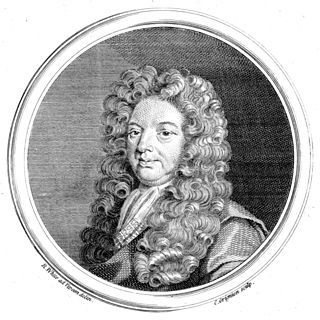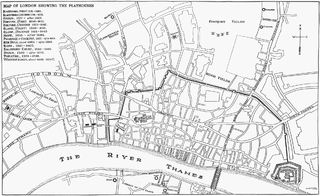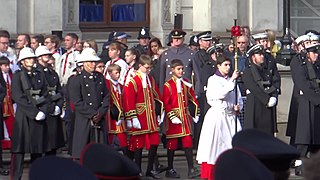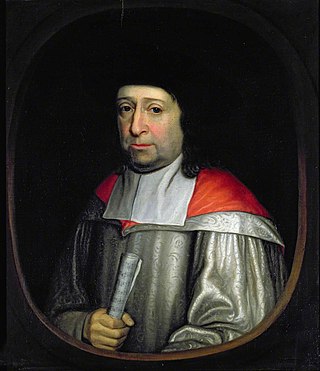
Henry Purcell was an English composer of Baroque music.

John Blow was an English composer and organist of the Baroque period. Appointed organist of Westminster Abbey in late 1668, his pupils included William Croft, Jeremiah Clarke and Henry Purcell. In 1685 he was named a private musician to James II. His only stage composition, Venus and Adonis, is thought to have influenced Henry Purcell's later opera Dido and Aeneas. In 1687, he became choirmaster at St Paul's Cathedral, where many of his pieces were performed. In 1699 he was appointed to the newly created post of Composer to the Chapel Royal.

Blackfriars Theatre was the name given to two separate theatres located in the former Blackfriars Dominican priory in the City of London during the Renaissance. The first theatre began as a venue for the Children of the Chapel Royal, child actors associated with the Queen's chapel choirs, and who from 1576 to 1584 staged plays in the vast hall of the former monastery. The second theatre dates from the purchase of the upper part of the priory and another building by James Burbage in 1596, which included the Parliament Chamber on the upper floor that was converted into the playhouse. The Children of the Chapel played in the theatre beginning in the autumn of 1600 until the King's Men took over in 1608. They successfully used it as their winter playhouse until all the theatres were closed in 1642 when the English Civil War began. In 1666, the entire area was destroyed in the Great Fire of London.

A chapel royal is an establishment in the British and Canadian royal households serving the spiritual needs of the sovereign and the royal family.
The Dean of the Chapel Royal, in any kingdom, can be the title of an official charged with oversight of that kingdom's chapel royal, the ecclesiastical establishment which is part of the royal household and ministers to it.

Matthew Wren was an influential English clergyman, bishop and scholar.
Pelham Humfrey was an English composer. He was the first of the new generation of English composers at the beginning of the Restoration to rise to prominence.
Henry Cooke commonly known as Captain Cooke, was an English composer, choirmaster and singer. He was a boy chorister in the Chapel Royal and by the outbreak of the English Civil War was a Gentleman of the Chapel Royal. He joined the Royalist cause, in the service of which he rose to the rank of captain. With the Restoration of Charles II he returned to the Chapel Royal as Master of the Children and was responsible for the rebuilding of the chapel and the introduction of instrumental music into the services. The choristers in his charge included his successor and eventual son-in-law Pelham Humfrey, as well as Henry Purcell, John Blow, William Turner, Robert Smith and Michael Wise.
Henry Hall was a 17th-century English composer of church and secular music and also a poet.
The Master of the Jewel Office was a position in the Royal Households of England, the Kingdom of Great Britain and the United Kingdom. The office holder was responsible for running the Jewel House, which houses the Crown Jewels. This role has, at various points in history, been called Master or Treasurer of the Jewel House, Master or Keeper of the Crown Jewels, Master or Keeper of the Regalia, and Keeper of the Jewel House. In 1967, the role was combined with Resident Governor of the Tower of London.

Richard Edwardes was an English poet, playwright, and composer; he was made a Gentleman of the Chapel Royal, and was master of the singing boys. He was known for his comedies and interludes. He was also rumoured to be an illegitimate son of Henry VIII.

The Children of the Chapel are the boys with unbroken voices, choristers, who form part of the Chapel Royal, the body of singers and priests serving the spiritual needs of their sovereign wherever they were called upon to do so. They were overseen by the Master of the Children of the Chapel Royal.

The Choir of St George's Chapel at Windsor Castle exists to sing services in St George's Chapel at Windsor Castle.

Christopher Gibbons was an English composer and organist of the Baroque period. He was the second son, and first surviving child of the composer Orlando Gibbons.
Nathaniel Giles was an English Renaissance organist and composer. He was the organist for Worcester Cathedral and wrote Anglican anthems.
Henry Evans was the Welsh scrivener and theatrical producer primarily responsible for organising and co-ordinating the activities of the Children of the Chapel and the Children of Paul's at Blackfriars Theatre for a short period in 1583–84. He later led a consortium of investors who leased the theatre during a much longer second phase, after the property was revived by Richard Burbage and Cuthbert Burbage.
Gentleman of the Chapel Royal is the office of an adult male singer of the Chapel Royal, the household choir of the monarchs of England.

Perpendicular Gothic architecture was the third and final style of English Gothic architecture developed in the Kingdom of England during the Late Middle Ages, typified by large windows, four-centred arches, straight vertical and horizontal lines in the tracery, and regular arch-topped rectangular panelling. Perpendicular was the prevailing style of Late Gothic architecture in England from the 14th century to the 17th century. Perpendicular was unique to the country: no equivalent arose in Continental Europe or elsewhere in the British Isles. Of all the Gothic architectural styles, Perpendicular was the first to experience a second wave of popularity from the 18th century on in Gothic Revival architecture.









